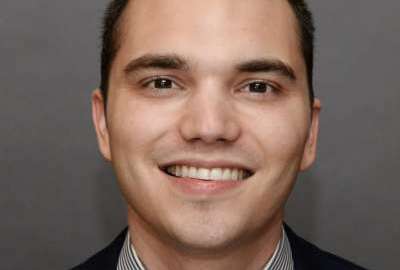
The benefit, curse of sensor technology pushes the Air Force to try something different
Frank Konieczny, the Air Force CIO, said the service is figuring out how to authenticate connected devices.
Best listening experience is on Chrome, Firefox or Safari. Subscribe to Ask the CIO’s audio interviews on Apple Podcasts or PodcastOne.
The Air Force has smart sensors. It has dumb sensors. But most of all, it has more of these devices than it knows what to do with.
The service is suffering both the benefit and the curse of these technologies.
Frank Konieczny, the chief technology officer for the Office of Information Dominance and chief information officer in the Air Force, said the service has been adding sensors or devices to trucks, planes, weapons, buildings and many other non-traditional items for decades, and now must figure out how to make the data more usable and accessible.

“You’d be surprised how many dumb sensors we have out there. The question we always have is how will we fuse all of these sensors together into some coherent strategy that we could actually look at?” Konieczny said at the recent AFCEA DC IoT conference in Washington. “There are multiple protocols out there for all the IoT devices and sensor that we have out there. We also don’t know if it’s an authenticated device or sensor or not. How do we know this is my sensor and the information I’m getting from a particular device? We are trying to figure out other authentication methods of doing this.”
This is why the service is looking at a possible approach to managing the sensors and harnessing all the data that comes from them.
“We are looking at various ways of consolidating ways of consolidating various Internet of Things (IoT) devices into a broker, if you will, and have the broker have some intelligence in it to understand what’s going on and to give us better readings as to the authentication of those particular devices or the trend that they appear to be telling us,” Konieczny said at the event, which was replayed on Ask the CIO. “There are tons of proprietary protocols and everything else. Some of the sensors don’t fire at the same speed and rate that is why we are talking about going to a broker that can understand some of this as well and decode all the protocols that are out there. The new ones are much better, they have some intelligence. The old ones, however, have no intelligence whatsoever. You have to figure out how to embed intelligence in them, I talked about changing the firmware, or you have to figure out another way of accepting all this at some rate of speed.”
He said the goal is to normalize and correlate the information coming from all the sensor to make it more useful to better manage buildings, vehicles and really anything that has a computer connected to it.
A broker, or maybe a better term is gateway, is a device that collects all of this data and makes sense of what’s going on.
In addition to the gateway or broker, Konieczny said the Air Force Research Lab developed software to fix the problem with dumb sensors.
“They take dumb IoT sensors, manipulate the firmware in such a way that they rebuild it and add an intelligence to that firmware to do a pulse back to wherever to authenticate,” he said. “It was something we didn’t think was possible, but they showed me in front on my eyes in my office so I was surprised. We are progressing down the path to try to authenticate it and trying to push together various ways to look at multiple sensors.”
AFRL researchers spun off that software into a company called Red Balloon Security.
The service recently tested some of these concepts to better use and harness the data from connected devices at Maxwell Air Force Base in Montgomery, Alabama.
“They tested out motion sensors, cameras and some badge readers. They are looking at sensors that can see what junk is on the runway,” he said. “If the runway is not cleared during take-off, you suck all that stuff into your engine and the engine blows up. You used to have airmen walking out there to make sure there wasn’t anything out there. Now they are trying to put sensors out there to basically do the same thing and detect various things on the runway. They are trying to do more of the HVAC in the buildings.”
Konieczny said the Air Force now is expanding the pilot across Maxwell and to other bases to better understand HVAC and electricity so they can understand how much power the base is using.
Latest Technology News
The long term goal is add sensors to more mission areas and start defending against potential threats.
“The idea is to start grabbing data from that mission thread to evaluate the risk factor for that mission threat,” Konieczny said. “One of those risk factors is going to be based on IoT sensors coming off all of those devices. That means not only servers, but tanker trucks, the airplane, the runway and everything else to associate this with a complete mission threat.”
Additionally, the Air Force has to figure out where to process all of this data that’s coming in from these sensors. At a base like Maxwell, the data center or cloud can handle the volume and veracity of the information.
But in the field, the service is looking at other approaches.
“Where do you want to process the sensor data and do you trust it? A lot of times you want to process it on the plane. Small scale processing units are now available. It’s a matter of actually putting them on the plane with low voltage so you have to figure out how to fit it into the mainframe you have and then figure out exactly what processing you want to do,” he said. “We are getting to the point where we are looking at some interesting things we may start pushing out, but again that takes a while to actually get it into production and push it out to a real airplane or drone.”
Konieczny said the Air Force also is starting to look at machine learning and artificial intelligence to help it better understand what’s really happening on its networks and devices.
“We are looking at where can we put a gateway, where can we actually start testing out the multitude of sensors we have? There will be a pilot or research or some other project to start looking at it from the stand point of whether I can do trend analysis and what processing capabilities do I need?” he said. “Right now we are basically researching. We are trying to find two bases, one simple and one with really old sensors on it and then look at it and see what we can do with it.”
Copyright © 2025 Federal News Network. All rights reserved. This website is not intended for users located within the European Economic Area.
Jason Miller is executive editor of Federal News Network and directs news coverage on the people, policy and programs of the federal government.
Follow @jmillerWFED
Related Stories

Scott Maucione: Alabama Air Force base to begin utilizing IoT and smart city technologies





